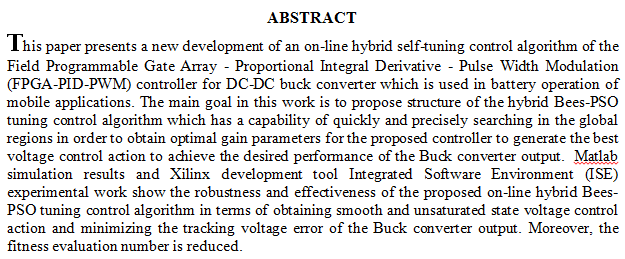
This work introduces the synthesis and the characterization of N-doped TiO2 and Co3O4 thin films prepared via DC reactive magnetron sputtering technique. N-doped TiO2 thin films was deposited on indium-tin oxide (ITO) conducting substrate at different nitrogen ratios, then the Co3O4 thin film was deposited onto the N-doped TiO2 layer to synthesize a double-layer TiO2-N/Co3O4 Photoelectrochromic device. Several techniques were used to characterize the produces which are x-ray diffraction (XRD), field emission-scanning electron microscopy (FE-SEM), Fourier-transform infrared (FTIR) spectroscopy and UV–Vis spectroscopy. The Photoelectrochromic device was characterized by UV–Vis spectroscopy and the results show that the double-layer N-dope
... Show More (3)
(3)
 (3)
(3)
The aim of the current research is to identify the self-control of kindergarten teachers as well as to identify the significance of the differences according to a variable (years of service, academic achievement, specialization). Its final paragraphs consist of (35) paragraphs, and its psychometric properties were verified and the tool was applied to a sample of (400) teachers chosen randomly from kindergarten teachers affiliated to the General Directorates of Education in Baghdad, Rusafa, and Karkh for the academic year 2019-2020
In light of the objectives of the current research, the following results were reached
- The current research sample is from kindergarten teachers with self-contro
- There are diffe
 (51)
(51)
 (45)
(45)
This study aimed to incorporate hydroxyapatite nanoparticles (nHA) or amorphous calcium phosphate nanoparticles (nACP) into a self-etch primer (SEP) to develop a simplified orthodontic bonding system with remineralizing and enamel preserving properties.
nHA and nACP were incorporated into a commercial SEP (Transbond™ plus) in 7% weight ratio and compared with the plain SEP as a control. Shear bond strengths (SBS), enamel damage, and adhesive remnant index (ARI) scores were evaluated at 24 h
 (12)
(12)
 (11)
(11)
Survivin, a member of inhibitor of apoptosis family is increasingly used as a target for cancer therapy design because it has a key role in cell growth and inhibition of cell apoptosis. Also it can be used as a biomarker for targeting cancer because it is found in almost all cancer but not normal cells. Our strategy was to design (computationally) a molecule to be used as survivin inhibitor. This molecule was named lead10 and was used furthermore to find (virtually) existing drugs with a good survivin inhibition activity.
Scheduling Timetables for courses in the big departments in the universities is a very hard problem and is often be solved by many previous works although results are partially optimal. This work implements the principle of an evolutionary algorithm by using genetic theories to solve the timetabling problem to get a random and full optimal timetable with the ability to generate a multi-solution timetable for each stage in the collage. The major idea is to generate course timetables automatically while discovering the area of constraints to get an optimal and flexible schedule with no redundancy through the change of a viable course timetable. The main contribution in this work is indicated by increasing the flexibility of generating opti
... Show More (17)
(17)
 (8)
(8)
The overlap between science and knowledge is a feature of the 21st century. This integration, which crosses the traditional boundaries between academic disciplines, has occurred because of the emergence of new needs and new professions. This overlap has overshadowed the arts in general and design in particular. The Design achievements have not been far away from the attempts of integration of more than one type or design application to produce new outputs unique in its functional and aesthetic character, including the terms of internal graphic design.
The researcher raises the question of the functional dimension of graphic design in the internal space, in order to answer it through the methodological framework, which includes th
... Show MoreObjective. Glass-ionomer and resin-modified glass-ionomer cements are versatile materials with the ability to form a direct bond with tooth tissues. The aim of this study was to formulate a novel class of dental bio-interactive restorative material (pRMGIC) based on resin-modified glass-ionomer cements via the inclusion of an organophosphorus monomer, ethylene glycol methacrylate phosphate, with a potential to improve the mechanical properties and also function as a reparative restorative material. Methods. pRMGIC was formulated with modification of the resin phase by forming mixes of ethylene glycol methacrylate phosphate (EGMP; 0–40%wt) and 2-hydroxyethyl methacrylate monomer into the liquid phase of a RMGIC (Fuji II LC, GC Corp.).
... Show More (7)
(7)
 (7)
(7)
 (25)
(25)
 (12)
(12)
This paper experimentally investigates the heating process of a hot water supply using a neural network implementation of a self-tuning PID controller on a microcontroller system. The Particle Swarm Optimization (PSO) algorithm employed in system tuning proved very effective, as it is simple and fast optimization algorithm. The PSO method for the PID parameters is executed on the Matlab platform in order to put these parameters in the real-time digital PID controller, which was experimented with in a pilot study on a microcontroller platform. Instead of the traditional phase angle power control (PAPC) method, the Cycle by Cycle Power Control (CBCPC) method is implemented because it yields better power factor and eliminates harmonics
... Show More